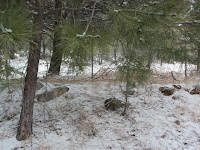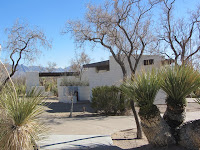Silver City is in the foothills of the Pinos Altos Range, south west New Mexico on the Continental Divide. It has a population of 10,500, is at an elevation of 6000 ft and is known for (amongst many other things) 'having 360 days of sunshine ...' Well we are in for a couple of days without sunshine!
 In 1870 a group of prospectors discovered silver in the hills above what would become Silver City. In 10 short months the newly christened Silver City grew from a single cabin to over 80 buildings. In the early years of development all of south western New Mexico was harassed by Apache raids. The nearest railroad terminal was in Colorado. Despite all odds Silver City flourished; its mills were producing $16,000 of bullion a week by 1875 and it soon became the supply centre for the booming industry. More homes were built, a volunteer fire department was formed, the telegraph line and then the Southern Pacific Railroad reached the town, telephone lines were installed and an electric light plant was completed in 1884.
In 1870 a group of prospectors discovered silver in the hills above what would become Silver City. In 10 short months the newly christened Silver City grew from a single cabin to over 80 buildings. In the early years of development all of south western New Mexico was harassed by Apache raids. The nearest railroad terminal was in Colorado. Despite all odds Silver City flourished; its mills were producing $16,000 of bullion a week by 1875 and it soon became the supply centre for the booming industry. More homes were built, a volunteer fire department was formed, the telegraph line and then the Southern Pacific Railroad reached the town, telephone lines were installed and an electric light plant was completed in 1884. But it was a shortlived boom. In 1893 the bottom dropped out of the silver market. Mines were closed. Silver City took a different path - cattle farming, new mineral discoveries and the development of the area as a TB convalescence haven helped stabilize the town and surrounding area.
But it was a shortlived boom. In 1893 the bottom dropped out of the silver market. Mines were closed. Silver City took a different path - cattle farming, new mineral discoveries and the development of the area as a TB convalescence haven helped stabilize the town and surrounding area.Prior to the discovery of silver was the discovery of gold. In 1859 a group of Forty-Niners drifting home from the California gold rush discovered gold in the Pinos Altos (Tall Pines) area just north of Silver City. Pinos Altos became a rough and tumble town of gold bonanzas and Apache raids.
Even earlier than those discoveries was that of copper. The oldest active mine in the southwest, the Santa Rita del Cobre (which became the Chino Mine) was worked as early as 1800, first by Apaches, then Spaniards, Mexicans and then in 1909 as an open pit copper mine by Americans. That too had a chequered history: the Apaches were so active in the area that the mine was surrendered up to them in the mid 19th century and it was only after the surrender of Geronimo, which marked the end of the Indian Wars, that the mine returned to use.
But man's presence in this area has been a long one. The pre-historic Mimbres Indians of the Mogollan culture inhabited the mountain wilderness from as early as 400AD!
We try to get up to the Gila Cliff Dwellings on our second morning in town but are beaten by the weather!
It was snowing as we left the RV Park. It had been 36 F, then dropped to 28 F.
 It is a 2 hour drive into the mountains and we make it to mile 14. The road is getting covered in snow; visibility is poor. I suggest we turn around.
It is a 2 hour drive into the mountains and we make it to mile 14. The road is getting covered in snow; visibility is poor. I suggest we turn around.So we go back to town. Find a coffee and a dog to talk to!





 |
| Pinos Altos |






 We then drive south to the City Of Rocks; amazing rock structures 32 miles south on Highway 180; a striking result of the geological process of erosion over time. And it looks like a city with streets and buildings. The temperature remains in the low 30's as we continue our drive into the Mimbre valley. It all looks terribly dry; there is a river somewhere but we seem to be constantly seeing dry beds. And then a road sign - winery!!! Could it be possible?
We then drive south to the City Of Rocks; amazing rock structures 32 miles south on Highway 180; a striking result of the geological process of erosion over time. And it looks like a city with streets and buildings. The temperature remains in the low 30's as we continue our drive into the Mimbre valley. It all looks terribly dry; there is a river somewhere but we seem to be constantly seeing dry beds. And then a road sign - winery!!! Could it be possible?We turn off to the winery. Sure enough! We have some tastings; quite a range including several reds. The best part of our visit is listening to the owner's history of the winery and her family's involvement in the area. She and her husband own and run the winery. The vines are watered by individual drip reticulation from underground springs. It was great!
 |
| Path to Visitors Centre at City Of Rocks |

Then back on the road to Silver City. We drive by the Chino Open Pit Mine, the oldest active mine in the Southwest.
Did I mention that Billy the Kid lived for several years in Silver City when he was a boy??

















































